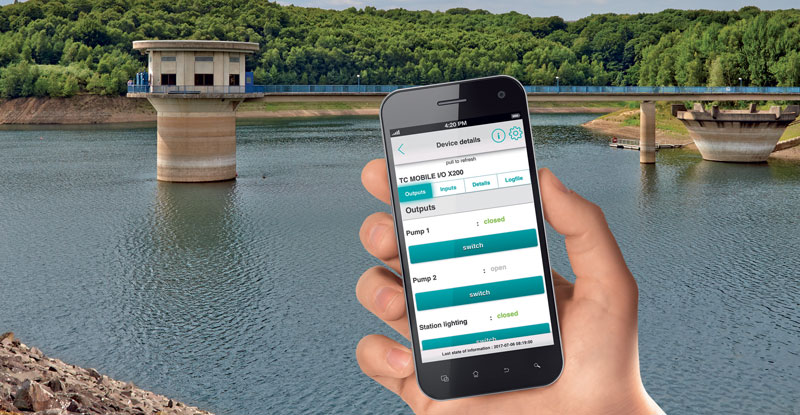Remote Control: Open Systems in Water Networks
With PLCnext Technology, Phoenix Contact offers an open automation platform which satisfy to the needs of plant operators as regards digitalization, IT security, modularity, and usability for water management systems
Remote control technology is an essential component in the automation of water management systems. In the course of digitalization, Ethernet-based solutions offer numerous advantages here, but also present some challenges. Operational considerations such as the integration of existing technology and access security can be solved easily with the PLCnext Technology automation platform from Phoenix Contact.

No separate hardware required
Also in the 1980’s, Phoenix Contact introduced Inline, its modular automation kit with control equipment, to the market. Using the Resy+ function block libraries, the Inline system not only helped automating plants and facilities, but could also serve as a remote control station at the same time. Internationally standardized protocols such as the IEC 60870-5-101/104 remote control standard or Modbus were already being used back then. This eliminated the need for any separate hardware. Thanks to the use of standard protocols, the Inline system was also compatible with other manufacturers’ solutions that were based on those standards. However, the complexity of the protocols remained an issue, even though the Resy+ remote control libraries helped to simplify startups and the diagnostics options, and thus resulted in a high degree of support for operators.
Now that digitalization has entered all industrial fields over the past years, lots of new requirements have emerged. Today, Ethernet is commonly used to exchange data with remote installations. Dedicated lines or analog dial-up connections are no longer available. The amount of information that results from the use of intelligent field devices – such as a drive with PROFINET connection – from the changes in maintenance strategy, and from the merging of individual public utilities and wastewater treatment plants into joint authorities urgently require alternatives to the classic remote control systems with their low transmission speeds.

How to face the new safety requirements
Digitalization has long since become a part of our private daily lives. More and more people are convinced by the advantages of smartphones, tablets, networked TVs, and PCs. But wherever there is light, there is shadow. With digitalization, new forms of crime have developed. The various options of Ethernet-based networking can also be used to substantially influence the availability of the technology. Reports of malware attacks and their serious consequences appear in the media on an almost daily basis. It is therefore crucial that the digitalization of processes is accompanied by a solid strategy for the implementation of IT security. Everyone has their very own opinion on the various topics of digitalization. Some operators might think that their systems don’t need further networking. Eventually however, the trend of digitalization cannot be held back. In order to benefit from the advantages of the digitalization when making systems and plants network, and in order to comply with the new safety requirements and the technological conditions for a consistently high system availability, the use of open systems should become the rule. Only these systems will offer the highest degree of flexibility and networking capability in the future.

An app for easy automation
With PLCnext Technology, Phoenix Contact has developed an open automation platform which tailors to the needs of plant operators as regards digitalization, IT security, modularity, usability, and efficiency. Among other things, the solutions stands out because the existing automation and remote control infrastructure can be used along with it. The input and output modules of the Inline automation kit installed years ago can thus remain in use.
Like the Inline controllers, the PLCnext controllers also combine automation and remote control equipment in a device which can also be used solely as a remote control station. As such, the solution meets all current requirements of IT security functions, for example, controller encryption and user authentication. In addition to the communication protocols commonly used in remote control, the PLCnext controllers support Ethernet-based standards including HTTPS, FTP, SNTP, SNMP, SMTP, SQL, MySQL, and DCP. The controllers can be programmed in high-level languages or the IEC 61131 standard language. Furthermore, ready-made functions such as Matlab Simulink can be used. Moreover, an integrated connection can be used to exchange data between the PLCnext conrollers and the Proficloud. This type of connection will become increasingly important in the future as it allows different pieces of information to be combined, for example, in order to draw conclusions on the optimum operation of a rain basin.

Outsourcing of plant infrastructure equipment into the cloud
For smaller operators, topics such as cloud or portal solutions also play an increasingly important role. The ever increasing requirements for the personnel’s IT knowledge and the corresponding equipment are the driving force here. Therefore, the entire plant infrastructure equipment can be outsourced into the cloud by means of so-called hosted control systems (portal solutions). Operators then no longer need their own hardware, don’t have to worry about access protection, and save on costs for equipment, software, and IT experts. Furthermore, the plant’s data can be accessed from anywhere and at any time by the personnel. Whether it’s about a new remote control infrastructure or the migration of an existing system: The PLCnext Technology ecosystem lays the foundations for the digital transformation in remote control technology while also meeting the requirements regarding IT security in accordance with industrial standards.

